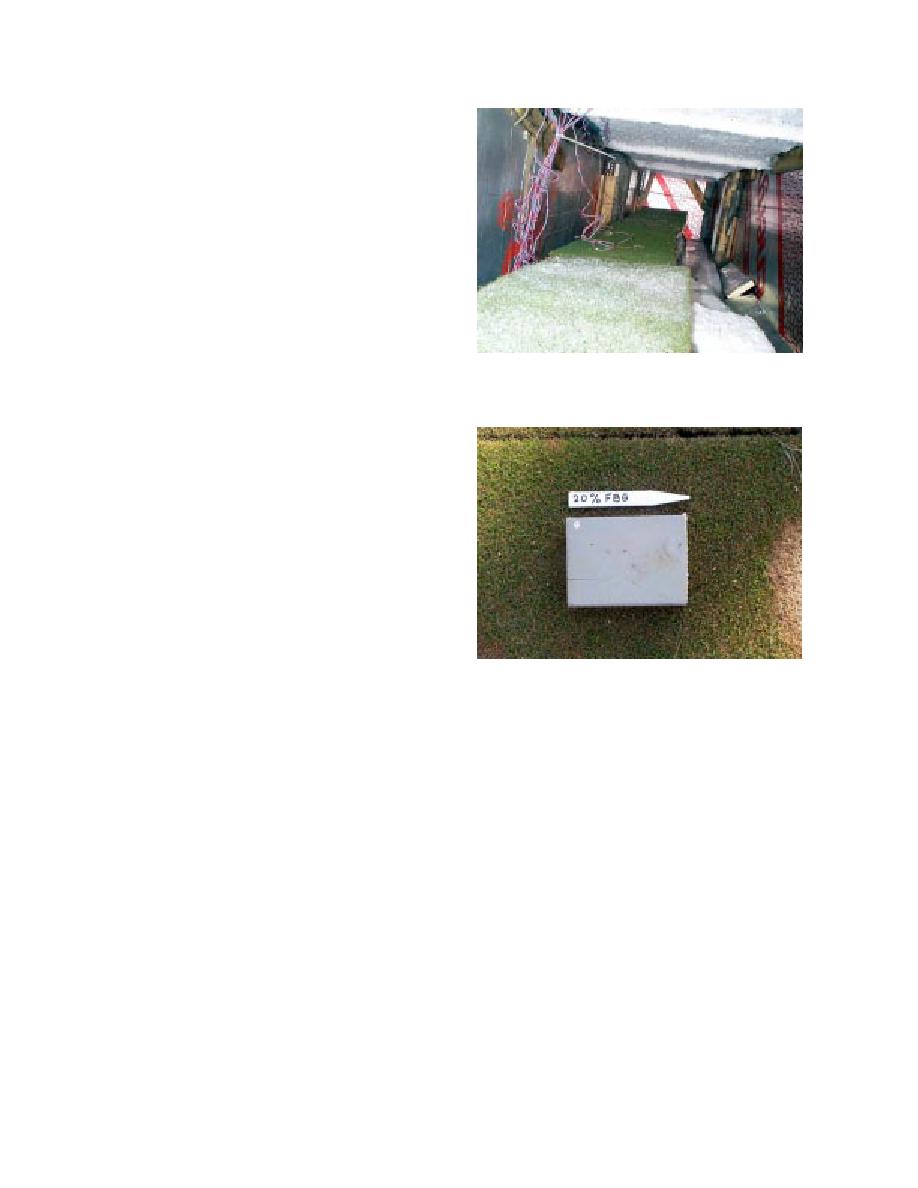
temperature of the ethylene glycol can be adjusted
to uniformly reduce ambient temperatures
enough to produce frost on objects near the plates
in a closed environment. Based on studies on for-
mation of frost in nature, the two major variables
for producing frost on plants would be the dis-
tance of the plants to the frost plate and the tem-
perature of the plates (Ryerson and Claffey 1994).
We found that it is possible to produce frost when
the plate temperature is set at 2C (23F) and the
plates were placed 30 cm (12 in.) above the plants.
This combination created an air temperature of
2C (28F) at the surface of the sod and took
approximately 30 minutes to produce frost on the
plants after the desired temperature was attained.
Figure 1. FERF frosting apparatus. Untreated,
Frost prevention
treated turf is in the background.
We conducted a series of experiments in fall
1996 and spring 1997 to determine the prevention
of frost on a mature creeping bentgrass sod (Agros-
tis palustris Huds.) treated with the FBG frost
inhibitor. The sod for each season's experiments
was cut with a sod cutter into 2-cm- (0.8-in.-) thick
sections of 0.3 m by 1 m (1 ft by 3.3 ft) from a prac-
tice green at the Hanover Country Club in Han-
over, New Hampshire. The sod was placed on a
sand bed adjacent to the CRREL greenhouse in
Hanover, New Hampshire. On the first and third
day prior to each experiment, the turfgrass sod
was irrigated with 1 cm (0.4 in.) of water. The sec-
ond day, the sod was fertilized with a complete
nutrient solution.
Figure 2. Wooden block used to compress turf to cause
On the fourth day, the sod was sprayed with
injury after frosting.
treatments consisting of FBG solutions of 0 to 20%
below a metal plate that circulated ethylene gly-
in water at an application rate of 1629 L ha1 (174
col (Fig. 1) to produce frost as described above.
gal. acre1). The FBG solutions used in the first two
After the frost plates reached the desired
frostings in 1996 included a gel agent to thicken
temperature, the surface of the sod was kept at
the solution and prevent its running off the leaf
2C (28F) for three hours. Temperatures at the
surface. The gel agent was a powdered additive
surface of the sod pieces were measured with
dispersed in the water-FBG solution at a concen-
unshielded thermocouples and recorded every 10
tration of approximately 0.25% by weight. The gel
minutes with a Model EL 824-GP data logger
that formed on stirring was clear, thick, and highly
(Omni Data International, Logan, Utah). The sod
viscous; it could be applied to the turfgrass with
was then placed back on the sand bed, and a 79-
conventional spray equipment, leaving a coating on
cm2 wooden block (Fig. 2) was placed on the turf
the leaf that would not run off the leaf surface even
surface, stepped on to compress the turf, and
after several hours. Subsequent trials were run
removed. Three hours after compression with the
without the gel agent. All applications were made
wooden block, the sod was irrigated with 1.25 cm
to completely cover the leaf surfaces, and there were
(0.5 in.) of water to prevent drying.
either two or three replications of each treatment.
Leaf color within the area compressed by the
Each replication for a single treatment used a full
wooden block was recorded and photographed
sod section.
after 48 hours (Fig. 3).
Six hours after treatment with FBG, the sod
In two series of tests, the same sod pieces were
pieces were transferred to the Frost Effects
frosted twice and FBG was applied before each
Research Facility (FERF) at CRREL and placed
2




 Previous Page
Previous Page
